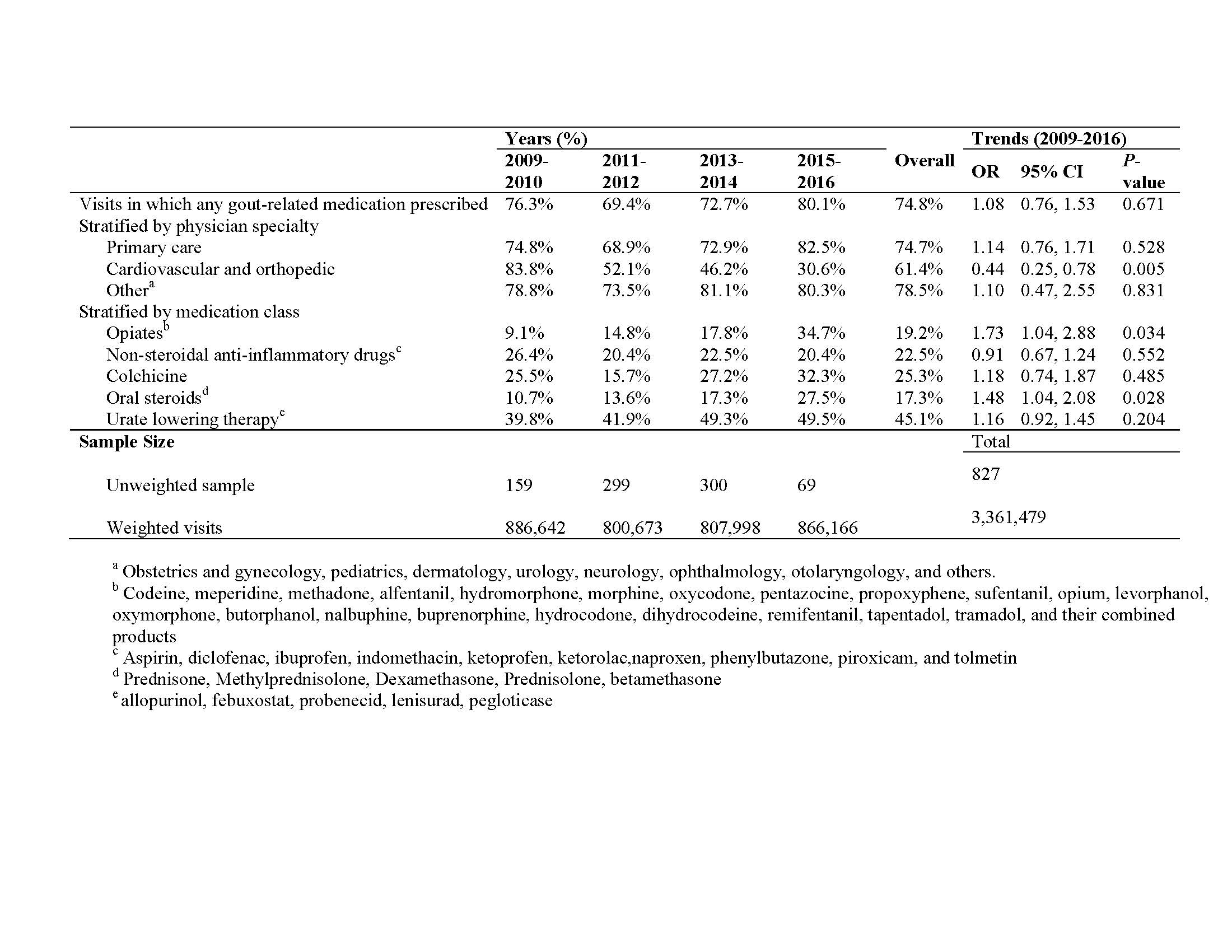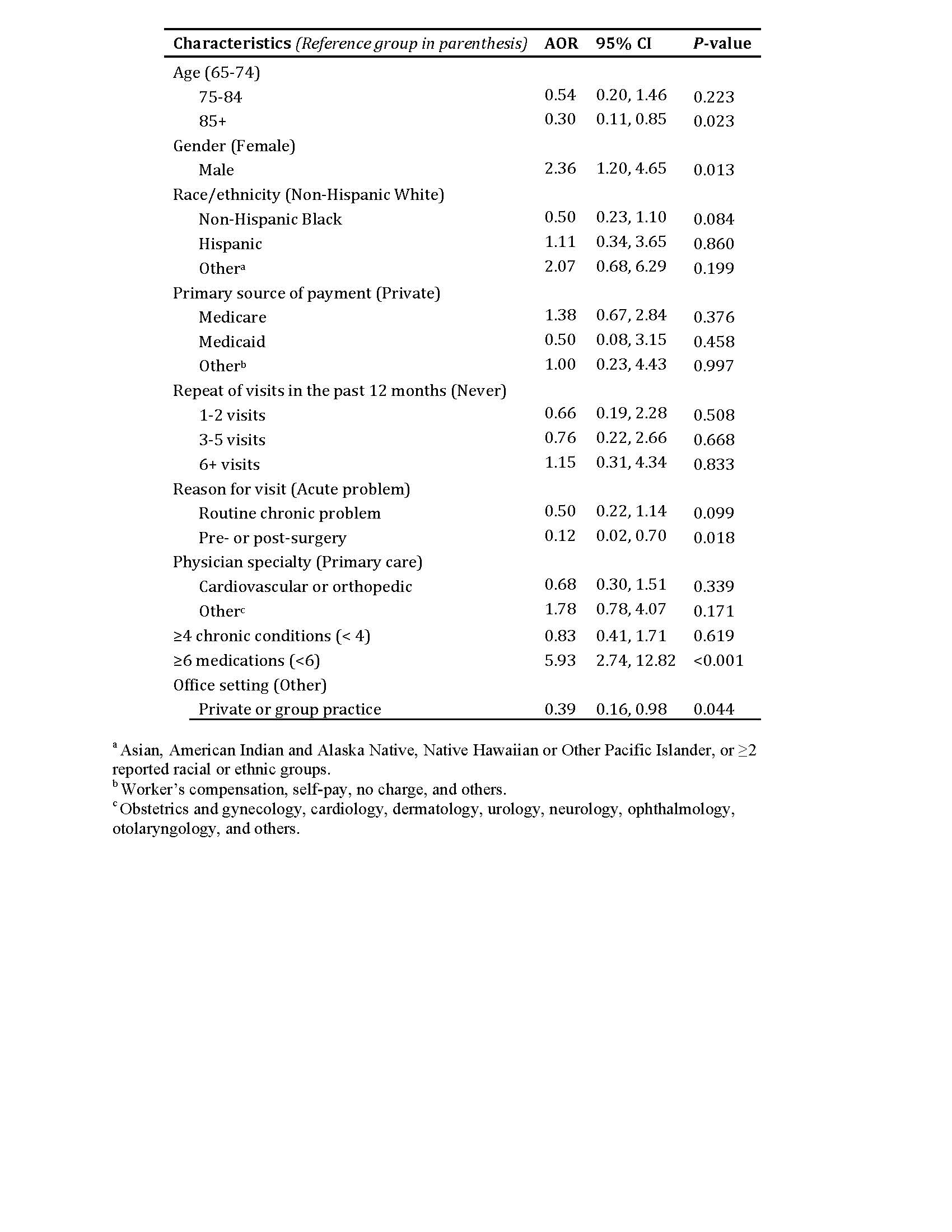Session Information
Date: Tuesday, November 12, 2019
Title: Epidemiology & Public Health Poster III: OA, Gout, & Other Diseases
Session Type: Poster Session (Tuesday)
Session Time: 9:00AM-11:00AM
Background/Purpose: Studies show that gout treatment remains suboptimal in the United States (US). Despite clear benefits for urate-lowering therapy (ULT) for chronic gout, surveyed physicians in the US are less likely to continue prescribing ULT after the first prescription. Prophylactic therapy was also infrequently prescribed concurrently with initial ULT. Our study investigates rates and trends of pharmacological treatments for gout in ambulatory office-base care from 2009 to 2016, along with factors associated with use.
Methods: We used data from 2009-2016 National Ambulatory Medical Care Surveys (NAMCS), a nationally representative sample of US office-based outpatient care. We included visits in which gout was diagnosed among adults age 18 or older (n=827 unweighted). We estimated prevalence and trends from 2009 to 2016 for the following medication classes for pharmacological treatments of gout: non-steroidal anti-inflammatory drugs (NSAIDs), colchicine, oral steroids, ULT, and opioids. Using a multivariable-adjusted logistic regression analysis, we examined associations between demographic and clinical characteristics and pharmacological treatments for gout.
Results: Between 2009-2016, there were 827 gout-diagnosed outpatient visits, representing 2.5 million office-based visits. Medication prescriptions occurred in 74.8% of these visits. Patients receiving prescriptions were predominantly aged 45 or older, male, and non-Hispanic white. When stratified by medication class, prescribing of opioids has monotonically increased from 9.1% in 2009-2010 to 34.7% in 2015-2016 (odds ratio [OR] for trends=1.73; 95% CI=1.04, 2.88); prescribing of oral steroids similarly increased from 10.7% in 2009-2010 to 27.5% in 2015-2016 (OR for trends=1.48; 95% CI=1.04, 2.08). Over the same period, prescription of ULT remained steady OR=1.16; 95% CI=0.92, 1.45). Patient factors independently associated with a higher likelihood of prescribing medications for gout were being male (adjusted odds ratio [AOR]=2.36; 95% CI=1.20, 4.65) and those with six or more medications concomitantly prescribed (AOR=5.93; 95% CI=2.74, 12.82). Studied medications were also less likely prescribed during visits pre and post surgery (AOR=0.12; 95%CI=0.02, 0.70).
Conclusion: Opioids and oral steroids were increasingly prescribed at initial gout visits while prescriptions of ULT and colchicine were unchanged over time. This suggests a concerning trend toward use of opiates in gout patients. Also, despite surgical intervention being a risk factor for gout flare, ULT may be underutilized in this population. Overall, our findings support the need for better understanding of optimal gout treatment among US clinicians and further research is needed to support improved treatment of gout.
To cite this abstract in AMA style:
Chock Y, Ross J, Suter L, Rhee T. Pharmacoepidemiology of Gout Treatment in Office-based Outpatient Care from 2009- 2016 [abstract]. Arthritis Rheumatol. 2019; 71 (suppl 10). https://acrabstracts.org/abstract/pharmacoepidemiology-of-gout-treatment-in-office-based-outpatient-care-from-2009-2016/. Accessed .« Back to 2019 ACR/ARP Annual Meeting
ACR Meeting Abstracts - https://acrabstracts.org/abstract/pharmacoepidemiology-of-gout-treatment-in-office-based-outpatient-care-from-2009-2016/



